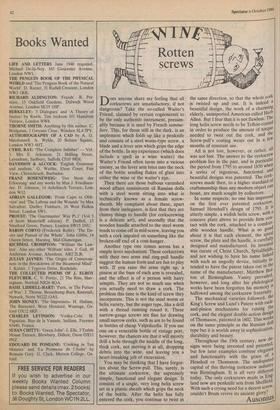1V r tn,
Rotten screws
Then there are those bulbous varnished wood affairs reminiscent of Russian dolls with a steel worm sitting into what is technically known as a female screw- sheath. My complaint about these, apart from their inelegance, is first that they are clumsy things to handle (for corkscrewing is a delicate art), and secondly that the wooden handle attached to the steel worm tends to come off in mid-screw, leaving you with a cork impaled on something like the broken-off end of a coat-hanger.
Another type one comes across has a simple lever mechanism. These corkscrews with their two arms and ring-pull handle suggest the human form and are fun to play with. If you raise the arms right up, a pinion at the base of each arm is revealed, and the effect is of a person with hairy armpits. They are not so much use when you actually need to draw a cork. The problem this time is the kind of screw they incorporate. This is not the steel worm or helix variety, but the auger type, like a drill with a thread running round it. These narrow-gauge screws are fine for drawing small narrow corks, such as are to be found in bottles of cheap Valpolicella. If you use one on a venerable bottle of vintage port, however, the chances are that it will merely drill a hole through the middle of the long, thick cork, not moving it at all, dropping debris into the wine, and leaving you a heart-breaking job of excavation.
You may be thinking that I have forgot- ten about the Screw-pull. This, surely, is the ultimate corkscrew, the supremely simple, functional and elegant design. It consists of a single, very long helix screw set in a plastic sheath which grips the neck of the bottle. After the helix has fully entered the cork, you continue to twist in
the same direction, so that the whole cork is twisted up and out. It is indeed, a beautiful design, the work of a charming elderly, unimported American called Herb Allen. But I fear that it is not flawless. The long helix screw needs to be Teflon-coaten in order to produce the amount of torque needed to twist out the cork, and the Screw-pull's coating wears out in a few months of constant use. All is not lost, however, or rather, all was not lost. The answer to the corkscrew problem lies in the past, and in particular the period from 1795 to around 1850 when a series of ingenious, functional and beautiful designs was patented. The cork- screws made then, to a higher standard of craftsmanship than any modern object can
boast, are much sought by collectors. ,
In some respects, no one has improve° on the first ever patented corkscrew., Samuel Henshall's design of 1795. It Is utterly simple, a widish helix screw, with a concave plate above to provide firm con- tact with the cork, attached to a comfort- able wooden handle. What is so about it is that each element', the spiral screw, the plate and the handle, is carefully designed and manufactured. Its inventor was curate of, Christ Church, Spitalfields, and not wishing to have his name linked with such an ungodly device, initially In" tended to have the patent taken out in the name of the manufacturer, Matthew Bo"
,
ton of Birmingham. Vanity prevailed, however, and long after his philological works have been forgotten his memory Is hallowed among the corkscrew fraternity. The mechanical varieties followed, the King's Screw and Lund's Patent with rack' and-pinion mechanisms for raising the cork, and the elegant double-action design of Thomason, patented in 1802. This works on the same principle as the Russian doll type but it is worlds away in sophistication, durability and beauty. Throughout the 19th century, new de- signs were being invented and patented, but few later examples combine elegance and functionality with the grace of Henshall or Thomason. The undisputed capital of this thriving corkscrew industrY was Birmingham. It is all very different today. The only corkscrews made in Eng" land now are penknife sets from Sheffield. With such a crying need for a decent screw, couldn't Brum revive its ancient glory?
AUS01111-1S














































 Previous page
Previous page